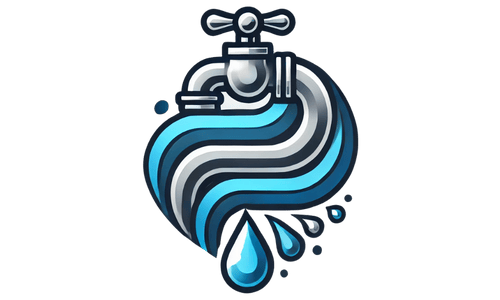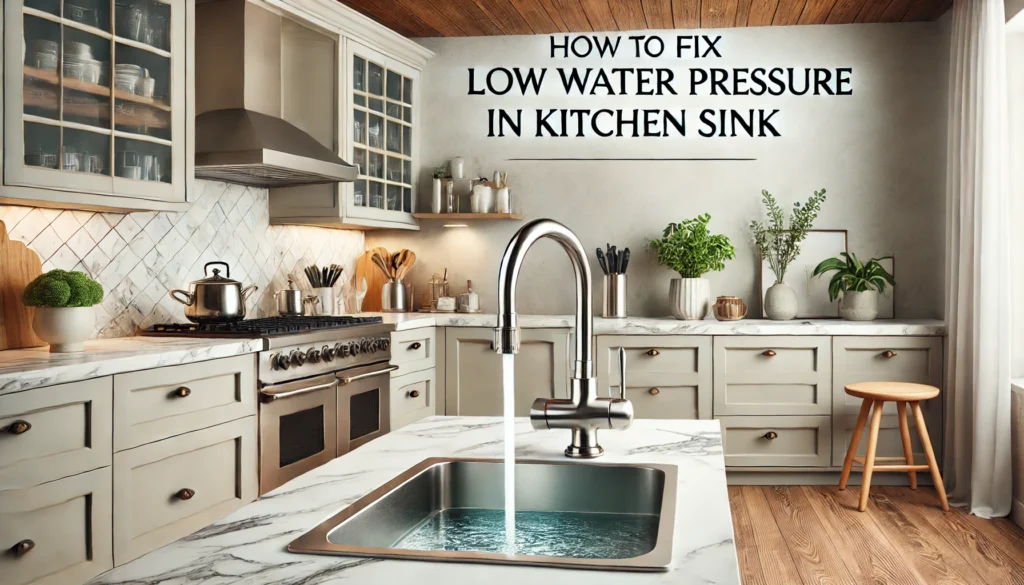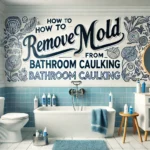Experiencing low water pressure in your kitchen sink can be frustrating, particularly when it affects your daily chores and cooking activities. This comprehensive guide will walk you through diagnosing and fixing low water pressure in your kitchen sink, ensuring a practical and systematic approach to resolving the issue.
Table of Contents
Introduction
Low water pressure in your kitchen sink can be a frustrating problem, but often, it’s caused by minor issues that you can fix yourself. One common culprit is a clogged aerator, which can restrict water flow. Unscrewing and cleaning the aerator can often resolve the problem.
However, if the issue persists, it may indicate more significant concerns, such as supply line blockages. Identifying the root cause is crucial to finding an effective fix.
Understanding Water Pressure Issues
To effectively address low water pressure in your kitchen sink, it’s crucial to understand the root cause. Water pressure problems can arise from both internal plumbing and external supply sources. By isolating the specific area affected, you can take the necessary corrective actions.
If the issue is confined to your kitchen sink, the problem likely lies within your home’s plumbing system. However, if the entire household is experiencing low pressure, the issue may stem from external supply sources, such as a faulty water meter or a problem with the municipal water supply.
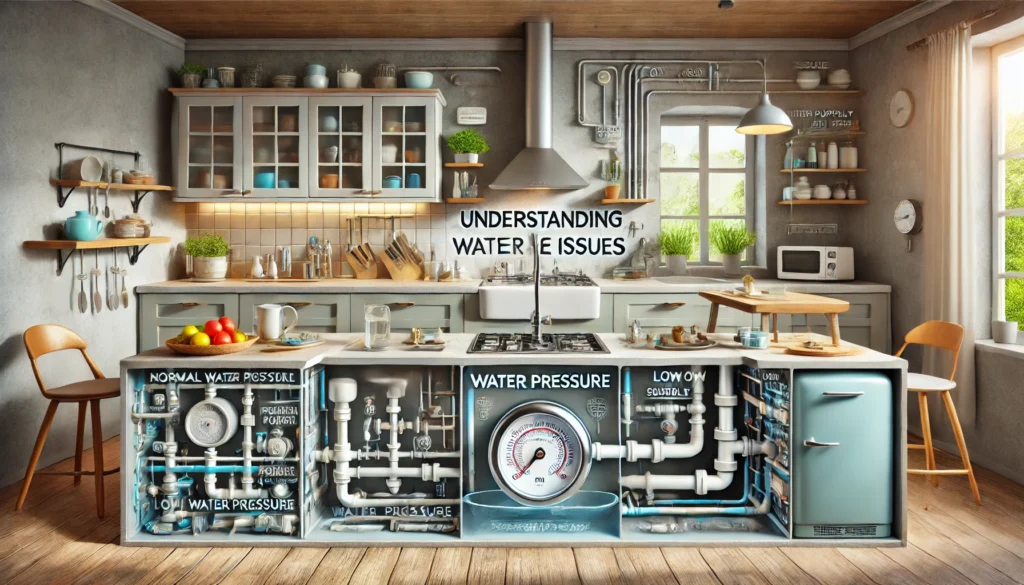
Preliminary Checks
Before delving into complex repairs, perform some basic checks. First, check other faucets in your home to determine if the low pressure issue is exclusive to your kitchen sink.
If only the kitchen sink is affected, inspect the area under the sink for any visible signs of leakage or damaged plumbing. Look along the pipes for any obvious leaks.
Next, evaluate the pressure valve to ensure it’s fully open. This valve, often located near the main water valve, controls the water flow to your kitchen sink. Fully open the valve to maximize water pressure.
Common Causes of Low Water Pressure
Clogged Aerator
A common culprit behind reduced flow from your faucet is a clogged aerator. This small, mesh-like screen at the faucet’s tip is designed to mix water with air, conserving water and softening the flow.
Over time, however, it can become clogged with minerals and debris from your water supply. This buildup restricts water flow, resulting in a weaker stream.
Faulty Diverter Valve
A malfunctioning diverter valve can significantly impact your water pressure. This valve, often located within your faucet, controls the water flow between the faucet and sprayer. When it’s not working correctly, it can restrict the normal flow of water to either outlet, leading to low water pressure.
Blocked or Damaged Pipes
Sediment Buildup and Damaged Pipes can restrict water flow. Mineral and debris accumulation within pipes, especially in older homes, can reduce water pressure. Physical pipe damage, like cracks or leaks, further hinders water flow.
Main Supply Issues
A common culprit behind low water pressure is municipal supply disruptions. These can arise from various reasons, including main water line breaks, scheduled maintenance, or unexpected issues within the municipal water system. When the water supply is interrupted or reduced, it directly impacts the water pressure in your home or building.
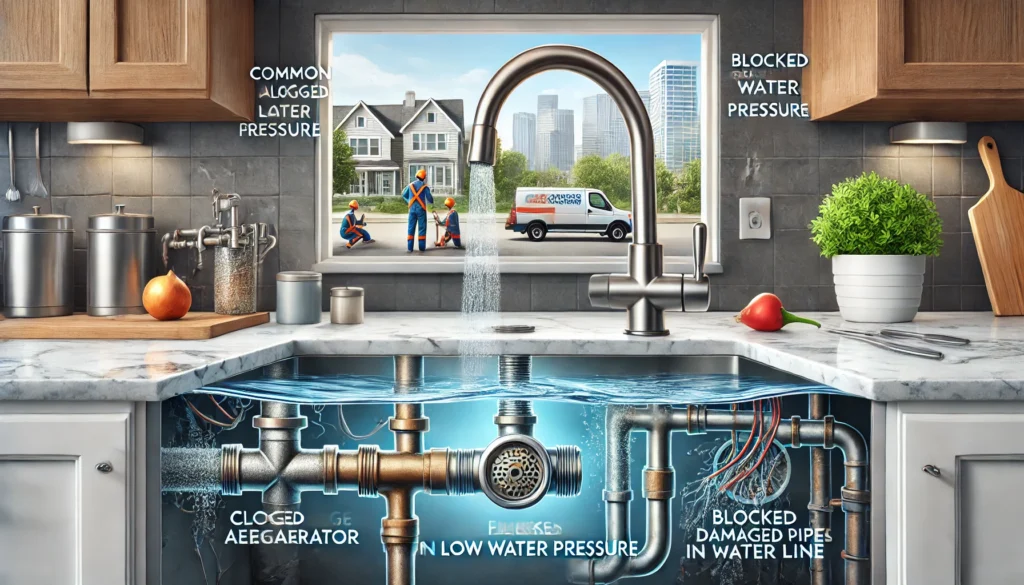
Step-by-Step Guide to Fix Low Water Pressure in Kitchen Sink
Cleaning the Aerator
To boost your kitchen sink’s water pressure, clean the aerator. This small, mesh-covered device at your faucet tip can clog with debris.
Unscrew it and soak in a vinegar-water solution to dissolve mineral deposits and loosen particles. Scrub with a soft brush and use a toothpick for stubborn clogs. Reattach the aerator for restored pressure.
Inspecting the Diverter Valve
A faulty diverter valve can cause low water pressure in your kitchen sink. This small component directs water flow between the faucet and the sprayer. When it malfunctions, it restricts water flow to the faucet, leading to low pressure.
To inspect the diverter valve, turn off the water supply and remove the aerator from the faucet spout. Unscrew the valve with pliers and check for damage or debris. Replace the valve if necessary.
If the valve is fine, check the faucet aerator or water supply line for obstructions.
Checking for Pipe Obstructions
To check for pipe obstructions, turn off the water supply and inspect the pipes under the sink for damage or cracks. If you find any issues, consult a plumber. For blockages, use a plumber’s snake or a chemical drain cleaner, but be cautious. Severe blockages may require professional help.
Assessing Main Water Supply
Before diving into the nitty-gritty of your kitchen sink, it’s crucial to assess the main water supply. Start by checking with your neighbors if they’re experiencing similar low water pressure issues. If so, the problem likely lies with the main supply coming into your home.
In this case, contacting your utility provider might be necessary. They can investigate any potential issues on their end. However, if you’re the only one facing this problem, it’s time to delve deeper into your plumbing system.
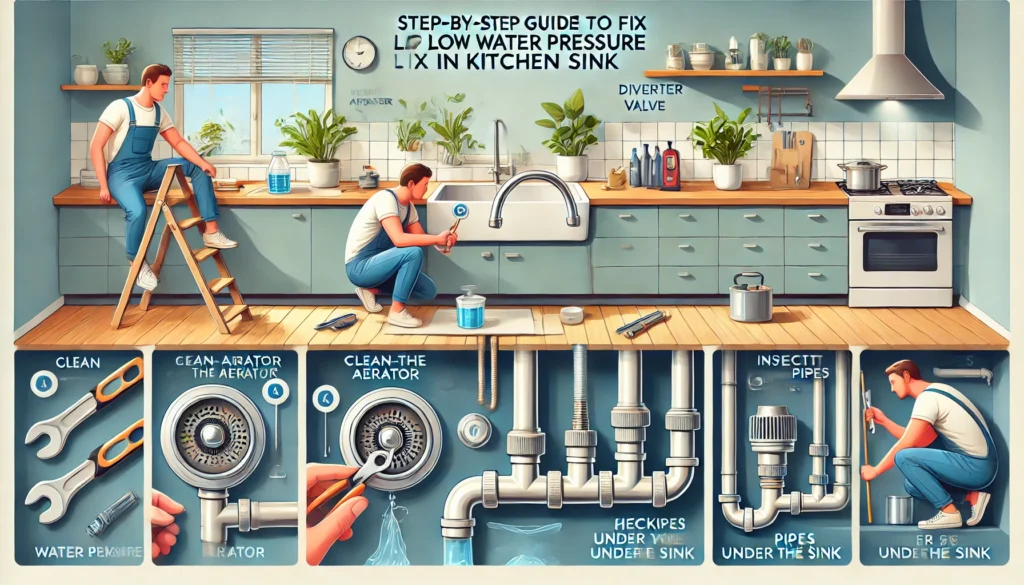
When to Call a Professional
If you’ve tried the above solutions and are still experiencing low water pressure in your kitchen sink, it’s time to call a professional plumber.
Complex issues like deep pipe blockages or supply line problems may require specialized tools and expertise to diagnose and fix. A plumber can assess the situation, identify the root cause, and recommend the most effective solution.
Preventive Measures
Regular maintenance is crucial to prevent common issues and maintain optimal water pressure. Cleaning aerators regularly can significantly improve water flow.
By inspecting plumbing for any potential leaks, you can effectively address them before they escalate. These simple steps can help you avoid low water pressure in your kitchen sink and ensure a smooth and efficient water flow.
Check Similar Guide: How Long Will a Wooden Sink Last?
Conclusion
Low water pressure in your kitchen sink can be a frustrating inconvenience. However, you can often resolve this issue with a few simple checks and DIY steps.
First, inspect your faucet aerator. This small device at the end of your faucet can become clogged with mineral deposits, restricting water flow. Unscrew the aerator, clean it thoroughly, and reattach it.
If the issue persists, check for any obstructions in your faucet’s supply lines. These lines can become clogged with debris or mineral deposits over time. Turn off the water supply to your sink, then access the supply lines and clear any blockages.
Frequently asked Questions
What causes low water pressure in kitchen sinks?
Low water pressure in kitchen sinks can be caused by clogged aerators, closed or partially closed valves, plumbing leaks, pipe obstructions, or corrosion within the pipes.
How can I check if the problem is with the aerator?
Remove the aerator from the faucet and test the water flow without it. If the pressure improves, the aerator is likely clogged and needs cleaning or replacing.
What should I do if cleaning the aerator doesn’t solve the problem?
If cleaning the aerator doesn’t improve the water pressure, check other components such as the faucet cartridge, water supply valves, and plumbing for any obstructions or leaks.
How do I inspect water supply valves?
Locate the water supply valves under the sink or in the basement. Ensure they are fully open by turning them counterclockwise. If they are stuck or hard to turn, they may need to be replaced.
Can a faulty faucet cartridge cause low water pressure?
Yes, a faulty or clogged faucet cartridge can restrict water flow and cause low pressure. Consider cleaning or replacing the cartridge if other fixes have not worked.
How do I know if my home has a pressure regulator?
Check near your main water supply line, typically where the line enters the house. A pressure regulator is a bell-shaped device and is often located near a shut-off valve.
What is the role of a pressure regulator in water pressure issues?
A pressure regulator helps maintain a consistent water pressure level within your home’s plumbing system. If it fails, it can either restrict flow too much or allow too high a pressure.
How often should I clean the aerator in my kitchen sink?
It’s good practice to clean the aerator at least once a year or more frequently if you notice a decrease in water flow or pressure.
What are some signs of plumbing leaks affecting water pressure?
Signs of plumbing leaks include visible water damage, damp walls or floors, a musty smell, or unexpectedly high water bills.
How can I test for leaks in my home’s plumbing?
Check your water meter, then avoid using any water for a couple of hours. Recheck the meter; if it has changed, there might be a leak. Also, listen for the sound of running water when all water is turned off.
What should I do if I suspect my pipes are corroded?
If you suspect corrosion, particularly if your home has older pipes, consider having a professional plumber inspect and potentially replace the affected piping.
Can installing a water softener help with water pressure issues?
If hard water and mineral deposits are a concern, installing a water softener can help prevent clogs in your plumbing system, potentially improving water pressure over time.
What immediate steps can I take if I notice low water pressure?
Start by checking if the issue is isolated to one sink or affects the whole house. Clean the aerator and check all valves are fully open as immediate first steps.
How do I adjust a pressure regulator?
To adjust a pressure regulator, you’ll need a wrench. Turn the adjustment screw clockwise to increase pressure or counterclockwise to decrease it. Be sure to check local codes or consult with a plumber, as improper adjustments can cause issues.
When should I replace my kitchen faucet to fix low water pressure?
Consider replacing your kitchen faucet if it is old, heavily corroded, or if none of the simpler fixes (like cleaning the aerator, checking valves, or replacing the cartridge) resolve the low pressure issue.
